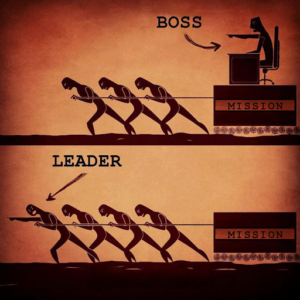Gun to your head, what is servant leadership?
If you hesitated, panicked, or peed a little in fear, you’re in good company.
Most people would meet Jesus before they could really answer that question.
According to this article in the peer-review journal Leadership Quarterly, it seems we’re having trouble nailing down the definition of servant leadership:
“Across the servant leadership literature, we found examples of poor conceptualization of servant leadership, and consequently poor measurement…Attempts to define servant leadership…have resulted in explanations too convoluted to be useful for both scholars and practitioners. Bearing this in mind, we offer a new definition of servant leadership…
Servant leadership is an (1) other–oriented approach to leadership (2) manifested through one–on–one prioritizing of follower individual needs and interests, (3) and outward reorienting of their concern for self towards concern for others within the organization and the larger community.”
Now, that’s a good definition, but it’s still a little wordy. (And to be honest, my smooth brain had to read it at least three times before I understood it.)
A simple Amazon search for a book on servant leadership returns 50 pages of results.
A Google search for servant leadership slaps you in the face with seven and a half million hits.
The top result from Greenleaf gives a less mouthy definition: “A servant-leader focuses primarily on the growth and well-being of people and the communities to which they belong.”
But I think I have a definition of servant leadership that clears it up even better, and I found it in an old notebook of mine from 2004:
Your Job in a Nutshell
Every aspect of a leader’s job boils down to one single point. If, at any time, you’re not sure if you’re doing the right thing, ask yourself one question: “Am I helping the band right now?” This will solve all your problems.
The band?
Yes, I was in band. Not A band. Band. High school band.
I went to a summer leadership camp in preparation to be a drum major for the marching band. (I wasn’t a band nerd, I was queen band nerd, thank you very much.)
I knew I was going to learn about leadership, but I didn’t know that those leadership skills would change my entire life.
What they taught at that camp was servant leadership (though they didn’t call it that back then.)
I took notes on every seminar they gave us. A lotta notes.
And years later, looking back on my notes, it’s clear that those principles transcend just band.
You can replace the word “band” with “team,” “company,” “business,” “church,” or any other group.
Fill in the blank: “Am I helping the ___ right now?”
Welcome to: Everything I Ever Needed To Know About Servant Leadership I Learned In Marching Band
To understand if you’re helping, you need to know the mission.
If you’re a business owner, it’s your job to define the company mission in clear terms so that everyone is on the same page.
Let’s go back to my notebook. I’ll it lay out for you the way I scribbled it eighteen years ago:
You are what you eat CONSISTENTLY.
E is for Effort. You must be consistent in your effort. (Never give up.)
It must be planned. “If you’re failing to plan you;re planning to fail.”
A is for Actions. Must be consistent. (You are sick, though your actions are still consistent.)
If actions speak louder than words, what are they saying?
Must be consistently planned and paced.
The inconsistent pace of a leader in the band yields and builds mistrust and chaos.
T is for Technique. Must be consistent.
Technique should be spread out evenly and consistently.
Teach consistency together as well as apart.
A -(You are here now)———————————————-> B
You cannot get what you want until you define it.
B needs a definition.
The entire journey is between points A and B.
Spirit = the Path from A to B.
A (System) —————————- Spirit —————————-> B (Success)
Plan ahead for obstacles.
Learn from your obstacles.
You need to know where you’re going.
Because poor preparation = a terrible path.
The quality of your preparation is essential.
If you prepare well and start well you will end well.
In order to create your map you need to be a visionary and a prophet.
A prophet looks into the future and says: “The obstacles will be thus. The landmarks will be thus.”
You Need a Map and a Compass.
Compass = consistency in the direction you’re traveling.
Drill reading is not about the dots on the page, it’s what happens in between.
System + Spirit = Success.
That was our mantra. We’d chant it like a cult.
They taught us that a leader’s job was to point the team toward our north star and use a clearly defined system, consistency, and uplifting spirit to get us there.
A Servant Leader Creates Safety
As a leader, you are in the people business. And people need to know they can count on you when times get tough. That’s where your consistency comes in.
Your ability to keep cool under pressure and adapt to whatever situation pops up inspires confidence in others. If they know you’ve got their back, then they don’t need to worry.
You focus on finding a solution, and you make sure, above all else, to keep your team safe.
(Safe? What are you keeping them safe from?)
The Beast.
To elaborate, let’s dive back into the notebook:
The beast lives with every marching band. (Band = beast food.)
The band must function as one body with unity and purpose to save itself from the beast.
There is no particular glory in being one part of the body or the other.
When a body functions in unity, it protects itself.
Weapons of the beast:
Sunshine
Too many clouds
Rain
Wet shoes
Equipment problems
PMS
Fights/internal struggles
Etc.
Creating a defense:
Build a wall between you and the beast.
The wall is built with happy people (they are the only resource.)
The beast is consistent and relentless.
Take a bullet for the body. Every time. YOU take it.
Never let Sally get hit. Protect her.
The Beast’s recruiting program:
As soon as Sally is hit, she joins the Beast’s army.
Negative comments = bullets.
Build the wall, brick by brick (happy person by happy person.)
1.) Find a couple pieces of dry wood.
(Find a couple of people in the band that you completely trust.)
Tell them, “I’ve got your back, I hope you’ve got mine.”
2.) Start the fire.
3.) Take the least damp wood you can find and stack it close to the fire.
(People almost ready to be on board.)
4.) Put most of the wet wood outside of the damp wood.
From Band To Business
In a business, the Beast is a toxic work culture. It is the opposite of “teamwork.” It is disunity. It severs the left arm from the right; so neither hand knows what the other is doing. It feeds on inefficiency. It’s that invisible barrier which cleaves apart the departments within your company.
Just like the band, your team is potential beast food. The more negativity and toxicity it can feed off of, the stronger the Beast gets.
Ignoring the Beast only increases its stranglehold on your business. It cannot be circumvented. It must be confronted head on.
Weapons of The Beast:
– Silos
– Mistrust
– Internal struggles
– Lack of cooperation
– Communication breakdowns
And who is Sally? Sally is anyone on your team. As a leader, it is your job to protect Sally from the Beast, because if you don’t, then Sally joins the dark side.
You fight the Beast with bricks. Bricks are happy people. They’re the positive role models on your team. They’re the people with pride in the company.
Pride: Turn the Spark into a Flame and Pass on the Energy
If you have some people fully on board and others quite there yet, you pair them together. Happiness and pride are contagious. If you put damp wood on the outside of a fire, that wood will dry out, contribute to, and sustain the flame.
But how to encourage pride in your team?
Back to the notebook:
Instilling Pride in the Band
One of the biggest issues in many bands is a lack of pride in its membership. When the band marches from place to place in a block, it is evident who is proud and who is not. Some members simply don’t “get it.” It is therefore the job of every leader in the band to exhibit pride in its membership and focus on the task at hand. The only way to instill pride and focus is to lead by example one hundred percent of the time. (“One hundred percent” includes time at school, in rehearsal, at a festival, in a parade, on a trip, at home, hanging with your friends, and all other times. One hundred percent means: ALL of the time!)
The power you get to help the band is as much as you earn. (From your peers.)
Work hard to outwardly display pride. Set an example.
If someone doesn’t have total pride, outwardly display it and they will start to as well.
If you don’t have total pride, outwardly display it and you will.
You have to act your way into a new way of thinking.
Change is difficult. Sometimes to make the change effective, it has to start from the outside in.
Your actions will speak louder than words.
– Don’t just look good. Sound good.
– Speak with respect and the utmost positivity
– Speak with a sense of ownership (my school my director, my band)
When to apply = when you’re on stage = when anyone can see you at all.
Anything negative will become a rumor – everyone will remember.
Negatives accumulate. Positives come and go.
PRIDE – ask for it, expect it from your group.
When do you do it? All the time.
When do you stop? Never.
Consistency.
How To Create Pride In Your Business
To inspire pride, you must first display pride. Pride in yourself, pride in your company mission, and pride in others.
Emotions are like germs – other people can catch what you’ve got.
That’s not woo-woo stuff, that’s science. It’s a phenomenon called “emotional contagion.” It stems from when we were children and mimicked the emotions of those around us.
Unfortunately, negative emotions are more contagious than positive emotions. (There’s the Beast again.)
Fear, sadness, and pain are powerfully contagious. That’s because our brains are hardwired to keep us safe, and way back when we fought bears with sticks, being able to recognize fear in another alerted us to danger.
That’s why it is so important for a leader to display positive emotions like pride, happiness, and confidence.
Have you ever been in a workplace where there was a change in upper management and the new vibe was just… off? A boss’ negative attitude will quickly spread through the entire company and turn it into a toxic workplace.
Servant leadership is about being a positive role model. A great leader promotes community. They work to create a sense of meaning and purpose in the mission. They don’t rely on fear as a motivator. They lead out of love.
Servant leaders show and encourage gratitude. Gratitude leads to pride. Reward your team members often. Acknowledge their accomplishments; both big and (especially) small. When it comes to leading from a place of love, the little things are everything.
How To Bring Pride to the Un-Proud (Or, the Future-Proud)
In a perfect world, everyone catches on to your good vibes and they all worked together and lived happily ever after, the end.
But this ain’t no fairy tale.
There will be problems. Some people won’t get it right away.
Here’s what the notebook says about that:
Problems
A person with a problem is a person who is crying for help.
You can do three things about it:
1.) Nothing – they drown.
2.) Make the problem worse – throw a brick at them, (they may even take the rest of the band down with them.)
3.) Throw them a life jacket – rescue them.
A Butthead is someone who craves more power than they have, and is willing to steal it.
Buttheads want attention.
Attention = power.
When you make an enemy, they will last longer than when you make a friend.
“Friends take maintenance, enemies last forever.”
Power struggles = wanting attention.
Four types of buttheads:
1.) Shoulda-been-me (don’t get drum major):
Wants band to be great, but also wants power.
Best solution: Give them power. They’re most likely competent.
Have them help out with freshmen.
2.) Generic bad attitude:
Find out a way to make them have fun.
Put them in between two stronger people. Sammich them between two positive people to cancel out their negative effect.
(Sometimes it’s a cancer. When there’s cancer in the arm, cut it off. Stop it from infecting the whole band.)
3.) Class Clown:
Disruptive just for the attention.
If nobody laughs at their jokes, they’ll stop telling jokes.
“Try not to laugh.”
4.) Butthead in disguise:
Loves the band. Wants to work hard. ALWAYS in the band room. Craving attention. Getting their voice out there. Lots of questions. Bad habits. Craves interaction.
Solution: Go to the person and talk with them about it.
Non-confrontational: “I like that you’re real eager to help out, but sometimes you’re asking too many questions. Maybe save them until afterwards, they’re disrupting the flow.”
Be honest, be nice.
Solving Problems
How to survive: be consistent.
Approach the problems all the same way.
Buttheads: greatest leaders waiting to be born.
Instructions aren’t supposed to be thrown, they’re supposed to be lofted.
People get it when they catch it.
Introduce any instruction or criticism with something positive.
Praise others in front of the group or individually.
Criticize others individually.
Be creative about how you acknowledge that they fixed the problem.
Make sure they see you, give them a silent thumbs up.
Solving problems: use common sense.
Don’t wait on it, it will always get worse.
Don’t let it fester.
Positive Sammich! (No Atkins!)
Bread – positive comment/compliment/praise
Meat – problem
Bread – something else good. Different type of positive acknowledgement
Example: Nice shirt. You suck. Nice shirt.
No Atkins!
A positive sammich (sandwich) is a way to soften the blow of any critical feedback or corrections.
Sandwich a criticism in between two compliments: “Nice shirt, you suck, nice shirt” is a bad example, but gets the point across. You want a positive first and last impression. You don’t want the person to feel cornered or attacked.
The positive sammich technique serves you well when you need to address actions.
When it comes to dealing with others’ emotions, refer to the “butthead” examples.
If they crave power, give them some responsibility. Allowing someone to take ownership is a way of instilling pride.
If they’re generally a downer, find a way for them have fun. How? Ask them! What would make them feel happier in their job? What are they craving? What are they missing?
Put them on a team with positive people. If that negative person is the damp wood, find a fire to lean them against. Warm them up.
Generally, if people crave attention, it’s because they crave more power. Give some to them.
Give Them Something To Be Proud Of
Remember, buttheads are great leaders waiting to be born. But first they need to feel like they’re a part of something worthwhile.
People need a sense belonging. They want to be a part of a community that shares their morals and principles. They want to work for a company that stands for the same things that they do. They need to feel valued. They want to have an important, impactful purpose.
As a servant leader, it is your job to make sure your team members have that meaning, that purpose, that community. A true leader supports from the bottom and holds everyone else up.
The best way to fulfill the wants and needs of your team is to ask them how.
How can I help you?
What do you need to [accomplish goal]?
What would make this easier/more fun/less stressful?
Because the more you know about your team, the better you can serve them.
That’s the whole point of servant leadership. The desire and ability to SERVE. If you serve your people, they will return the favor.
“The good leader carries water for his people.” – Laozi
Simply put, servant leadership is about making sure your team members have everything they need in order to accomplish the group goal.
It’s about asking yourself the question, “Am I helping the team right now?”
It’s not about being a boss. It’s about being a leader.
“Servant leadership is just leadership.” – Ryan Chute








